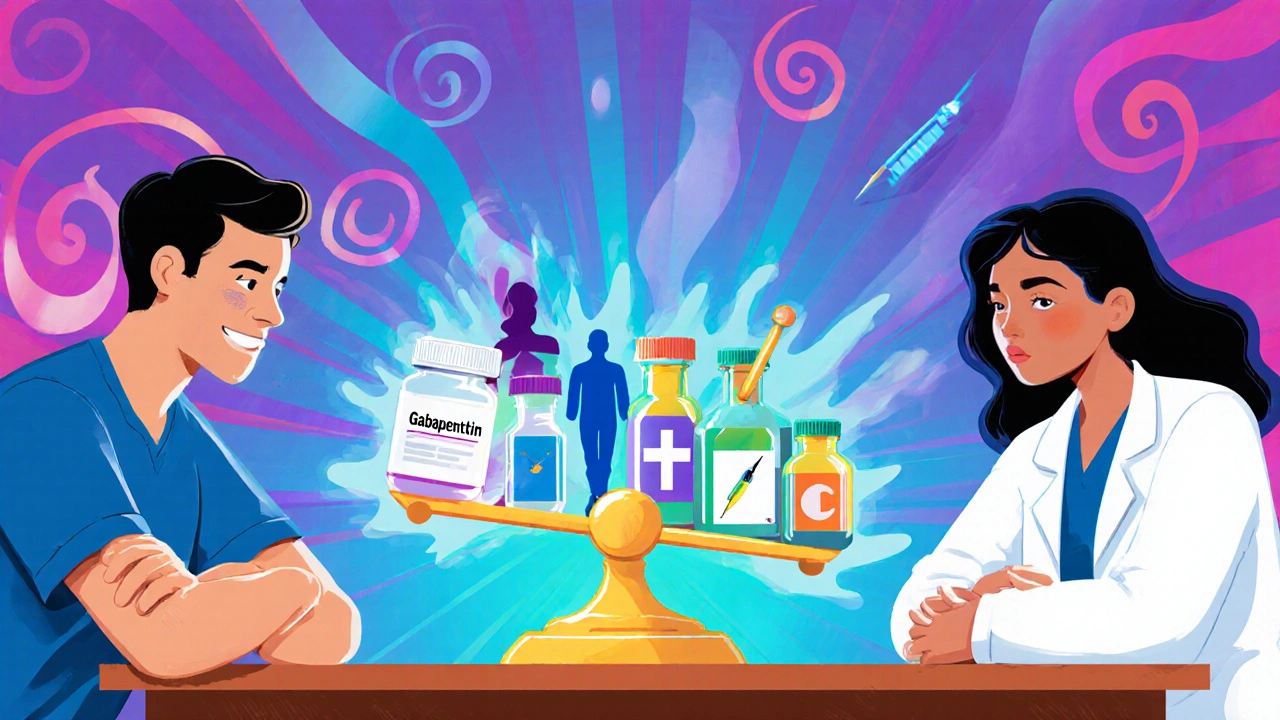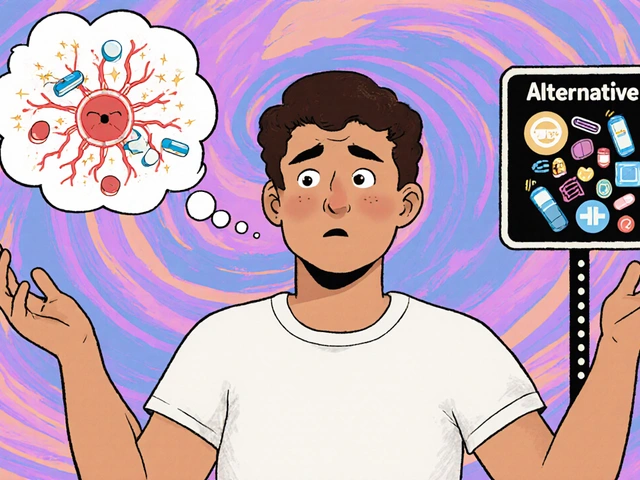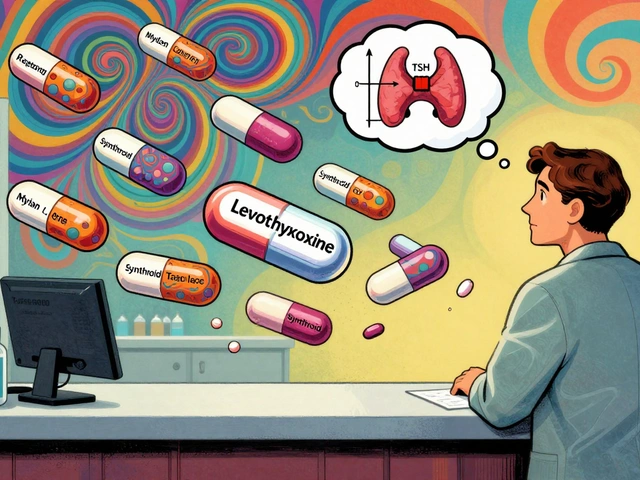
Feeling confused about whether Gabapentin (Neurontin) or another medication is the better choice for your nerve pain, seizures, or restless‑leg symptoms? You’re not alone. This guide breaks down the most common alternatives, compares key factors like effectiveness, side‑effects, dosing, and cost, and helps you decide which option fits your health goals.
What is Gabapentin?
Gabapentin is a synthetic analogue of the neurotransmitter gamma‑aminobutyric acid (GABA) that was originally approved to treat seizures. Over the years doctors discovered it also calms nerve‑related pain, making it a go‑to for conditions such as diabetic peripheral neuropathy, post‑herpetic neuralgia, and restless‑leg syndrome.
Gabapentin works by binding to the α2δ subunit of voltage‑gated calcium channels, which reduces the release of excitatory neurotransmitters. The result is less “over‑firing” of nerves that cause sharp, burning, or tingling sensations.
Typical Dosing and Formulations
- Immediate‑release capsules or tablets: 300 mg to 900 mg per day, divided into 2-3 doses.
- Extended‑release (Gabapentin ER): 300 mg to 2 400 mg once daily.
Doctors usually start low and increase gradually to minimise side‑effects like dizziness, fatigue, or mild swelling.
Why Look at Alternatives?
Not everyone tolerates Gabapentin well. Some patients experience excessive drowsiness, balance problems, or weight gain. Others need faster pain relief, or their insurance won’t cover the drug. In those cases, clinicians consider alternatives that target the same pathways or address the same symptoms with a different side‑effect profile.
Decision Criteria - What to Compare
- Efficacy: How well does the drug relieve neuropathic pain or control seizures?
- Onset of Action: How quickly do you feel relief?
- Side‑Effect Profile: Which adverse effects are most common, and how severe are they?
- Dosing Convenience: Once‑daily vs. multiple doses per day.
- Drug Interactions: Risks when combined with other medicines you take.
- Cost & Insurance Coverage: Average price per month and typical reimbursement.
Comparison Table: Gabapentin and Major Alternatives
| Medication | Primary Indications | Typical Starting Dose | Onset of Pain Relief | Common Side‑Effects | Average Monthly Cost (UK) |
|---|---|---|---|---|---|
| Gabapentin | Neuropathic pain, seizures, restless‑leg syndrome | 300 mg 2‑3 × day | 1-2 weeks | Dizziness, fatigue, edema | £12‑£30 (generic) |
| Pregabalin | Neuropathic pain, fibromyalgia, generalized anxiety | 75 mg 2 × day | 3‑7 days | Weight gain, peripheral edema, blurred vision | £25‑£45 (brand Lyrica) / £15‑£30 (generic) |
| Duloxetine | Diabetic neuropathy, major depressive disorder, chronic musculoskeletal pain | 30 mg daily | 1‑2 weeks | Nausea, dry mouth, insomnia | £20‑£40 |
| Amitriptyline | Neuropathic pain, migraine prophylaxis, depression | 10‑25 mg at bedtime | 2‑3 weeks | Constipation, weight gain, cardiac conduction issues | £5‑£12 |
| Carbamazepine | Trigeminal neuralgia, focal seizures | 200 mg 2‑3 × day | 1‑2 weeks | Hyponatremia, rash, liver enzyme elevation | £8‑£22 |
| Topiramate | Seizures, migraine prophylaxis, off‑label neuropathic pain | 25 mg daily | 2‑4 weeks | Cognitive slowing, paresthesia, kidney stones | £10‑£25 |
| Opioids (e.g., tramadol) | Severe acute pain, some neuropathic pain (short term) | 50 mg every 4‑6 h | Immediate | Dependence, constipation, respiratory depression | £15‑£35 |
| Non‑drug: Physical therapy | Neuropathic pain secondary to injury or diabetic neuropathy | N/A | Variable (weeks‑months) | None | £30‑£80 per session |
| Non‑drug: Acupuncture | Chronic nerve pain, restless‑leg symptoms | N/A | Variable (weeks) | Minor bruising | £40‑£100 per course |
Deep Dive into the Top Alternatives
Pregabalin (Lyrica)
Pregabalin is chemically close to Gabapentin but has higher bioavailability (≈90 % vs. 60 %). This means the drug reaches the bloodstream faster, often giving quicker pain relief. It’s FDA‑approved for fibromyalgia and generalized anxiety disorder, making it a versatile choice if you also struggle with mood symptoms. However, it can cause noticeable weight gain and swelling, so patients with heart failure need careful monitoring.
Duloxetine (Cymbalta)
Duloxetine is a serotonin‑norepinephrine reuptake inhibitor (SNRI) that targets pain pathways in the brain rather than at the nerve level. It works well for diabetic neuropathy and chronic musculoskeletal pain, especially when depression co‑exists. Because it affects neurotransmitters, you might feel nausea or dry mouth at the start, but these effects usually fade after a couple of weeks. A major plus is once‑daily dosing.
Amitriptyline
Amitriptyline is an older tricyclic antidepressant that doubles as a neuropathic pain reliever. It blocks the reuptake of serotonin and norepinephrine while also acting as an antihistamine, which explains its sedating effect-useful if pain keeps you awake at night. The downside is anticholinergic side‑effects like constipation and potential heart rhythm changes, especially in patients over 60.
Carbamazepine
Primarily used for trigeminal neuralgia, carbamazepine stabilises hyper‑excitable nerve membranes. It can be a solid option for sharp, shooting facial pain that Gabapentin sometimes fails to control. Watch for blood‑level monitoring because the drug can lower sodium levels (hyponatremia) and cause rash that may progress to Stevens‑Johnson syndrome.
Topiramate
Topiramate is another anticonvulsant that reduces neuronal firing by blocking sodium channels and enhancing GABA activity. Some clinicians prescribe it off‑label for painful neuropathy after other drugs fail. Cognitive side‑effects-often described as “brain fog”-are the main reason many stop the medication.
Opioids (e.g., Tramadol)
Opioids can knock down severe pain quickly, but they carry a high risk of tolerance, dependence, and dangerous respiratory depression. Guidelines now reserve them for short‑term rescue use when other options are ineffective. If your doctor prescribes an opioid, expect strict monitoring and a tapering plan.
Non‑Drug Options
Physical therapy focuses on strengthening muscles, improving circulation, and teaching nerve‑desensitising exercises. Regular sessions often lower pain scores by 20‑30 % without side‑effects. Acupuncture, though evidence varies, has helped many patients reduce neuropathic discomfort through needle‑induced release of endogenous opioids.
How to Choose the Right Treatment
Start by listing your core priorities: rapid relief, minimal sedation, cost, or a drug that also tackles anxiety or depression. Then match those priorities against the decision criteria above. For example:
- If you need fast relief and can afford a brand, Pregabalin is a strong candidate.
- If you also have depression, Duloxetine kills two birds with one stone.
- If you’re over 65 and worried about heart issues, Amitriptyline might be too risky-consider low‑dose Gabapentin or physical therapy instead.
- If cost is the main hurdle, generic Gabapentin or Amitriptyline are the cheapest options.
Never switch or combine these drugs without a clinician’s guidance. Interactions-especially between gabapentinoids and CNS depressants-can increase dizziness or respiratory depression.

Managing Common Side‑Effects
Most gabapentinoid side‑effects are dose‑related. A simple trick is to split the daily dose into smaller, more frequent chunks. Taking the medication with food can blunt stomach upset. If you notice swelling, a short sodium‑restricted diet and a diuretic (prescribed by your doctor) may help. Persistent dizziness that interferes with daily tasks warrants a dose reduction or a trial of an alternative.
When to Seek Professional Help
Contact your prescriber if you experience any of the following:
- Severe skin rash or blistering (possible allergic reaction).
- Unexplained weight gain >5 % of body weight in a month.
- New or worsening depression or suicidal thoughts.
- Swelling of the ankles or shortness of breath.
These signals could indicate a serious adverse reaction that needs a medication change.
Bottom Line
Gabapentin remains a solid first‑line choice for many forms of nerve pain and seizures, thanks to its safety record and low cost. Yet, a host of alternatives-Pregabalin, duloxetine, amitriptyline, and even non‑drug therapies-provide tailored solutions when Gabapentin falls short. By weighing efficacy, side‑effects, dosing convenience, and price, you can work with your doctor to craft a regimen that actually improves your quality of life.
Can I take Gabapentin and Pregabalin together?
Generally, doctors avoid combining Gabapentin with Pregabalin because both act on the same calcium‑channel subunit, which can amplify side‑effects like dizziness and swelling without adding much extra pain relief.
Is Gabapentin effective for restless‑leg syndrome?
Yes, many patients find low‑dose Gabapentin reduces the uncomfortable sensations and improves sleep quality, though response rates vary between 40‑60 %.
What’s the biggest advantage of duloxetine over Gabapentin?
Duloxetine also treats depression and anxiety, so patients with mixed mood‑pain profiles often achieve better overall improvement with one pill.
Are there any long‑term risks with Gabapentin?
Long‑term use is generally safe, but rare cases of dependence and withdrawal symptoms have been reported, especially after high doses.
How do I know if a non‑drug therapy is right for me?
If medication side‑effects outweigh benefits, or you prefer a holistic approach, start with a trial of physical therapy or acupuncture for 6‑8 weeks and track pain scores. Improvement of 20 % or more suggests the method is worth continuing.





eko lennon
October 25, 2025 AT 20:40When you first step into the labyrinth of neuropathic pain management, the sheer number of options can feel like an endless hallway of flickering fluorescent lights, each promising relief but casting its own shadows.
Gabapentin, the venerable workhorse, has earned its place by dampening the hyper‑active calcium channels that drive those painful nerve fires, yet its slow onset and tendency to cause drowsiness make many patients search for a faster, cleaner alternative.
Pregabalin, chemically its more potent sibling, boasts higher bioavailability and often reaches therapeutic levels within days, but the trade‑off comes in the form of weight gain and peripheral edema that can be especially troublesome for patients with cardiac compromise.
Duloxetine, a serotonin‑norepinephrine reuptake inhibitor, shifts the battlefield from the peripheral nerve to central pain processing, delivering a dual‑action punch that can simultaneously lift mood and blunt pain, though newcomers must weather a brief storm of nausea and dry mouth.
Amitriptyline, the classic tricyclic, brings a sedating embrace that can be a boon for nocturnal pain, but its anticholinergic side‑effects demand careful dosing in older adults to avoid constipation and cardiac conduction delays.
For focal facial pain, carbamazepine remains the gold standard, stabilising hyper‑excitable membranes, yet its requirement for regular blood monitoring and the risk of hyponatremia can deter long‑term use.
Topiramate, though primarily an anti‑seizure agent, has carved a niche in refractory neuropathy, but the cognitive fog it occasionally imposes forces many to abandon it after a short trial.
When speed is of the essence, short‑acting opioids such as tramadol can provide immediate relief, but the specter of dependence and respiratory depression looms large, prompting clinicians to reserve them for brief rescue periods.
Non‑pharmacologic avenues, like targeted physical therapy, aim to restore microcirculation and strengthen supporting musculature, often yielding a modest 20‑30 % pain reduction without any systemic burden.
Acupuncture, leveraging the body’s endogenous opioid cascade, has shown promise in small trials, offering a low‑risk adjunct for patients weary of pills.
Cost considerations also shape the decision tree: generic gabapentin and amitriptyline sit at the bottom of the price ladder, while branded pregabalin and duloxetine can climb higher, especially in health systems lacking generous subsidies.
Insurance formularies may force a step‑therapy approach, nudging patients toward the cheapest effective agent before approving more expensive alternatives.
Ultimately, the choice hinges on three personal pillars: how quickly you need relief, how much sedation you can tolerate, and whether you have co‑existing mood or cardiac conditions that tip the scales toward one molecule or another.
Discuss these variables openly with your prescriber, and consider a trial period of four to six weeks for each agent, monitoring pain scores, side‑effect burden, and functional improvement before committing to a long‑term plan.
Remember, the journey to pain control is rarely linear; thoughtful titration, occasional drug holidays, and a willingness to combine pharmacologic and non‑pharmacologic strategies often produce the most sustainable outcomes.
Sunita Basnet
October 31, 2025 AT 15:50Great overview thanks for breaking down the pharmacodynamics and health‑economics effectively you’re basically giving a roadmap for clinicians and patients alike the synergy between SNRI mechanisms and gabapentinoid pathways is especially valuable for multimodal pain protocols keep leveraging those insights forward
Melody Barton
November 6, 2025 AT 11:00Listen, if you’re tired of the constant drowsy fog from gabapentin you need to push for a faster acting option like pregabalin and demand a dose tweak from your doctor right now because waiting weeks is not an excuse when the pain is ruining your day
Justin Scherer
November 12, 2025 AT 06:10Switching meds can be a game changer.
Pamela Clark
November 18, 2025 AT 01:20Oh sure, because nothing says “I care about your health” like hopping from one pricey brand to the next while the insurance company watches you like a hawk.
Diane Holding
November 23, 2025 AT 20:30Consider your budget, side‑effect profile, and any comorbid mood issues before settling on a single drug.
Manish Verma
November 29, 2025 AT 15:40Honestly, the whole “just follow the guidelines” mantra sounds like a UK‑centric echo; in down‑under we’ve always trusted straight‑talk and real‑world evidence over textbook hype, so test the water with a low dose of duloxetine and see if it cuts the anxiety‑pain loop without the bloat.
Lionel du Plessis
December 5, 2025 AT 10:50the non‑drug options like PT or acupuncture give a steady baseline relief without adding meds you can just add them to your regimen
Andrae Powel
December 11, 2025 AT 06:00When titrating gabapentin, start with 300 mg at night and increase by 300 mg every 3‑5 days as tolerated; if dizziness spikes, split the dose into smaller fractions or take it with food, and always keep a medication log to track both pain scores and any adverse effects so your clinician can make data‑driven adjustments.